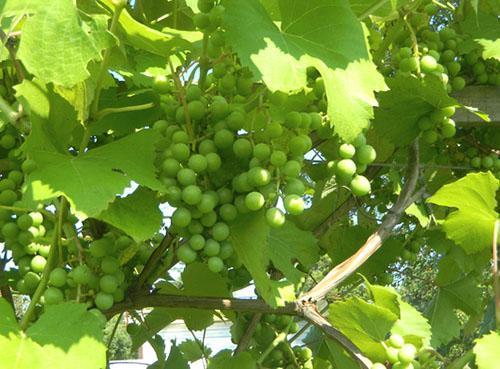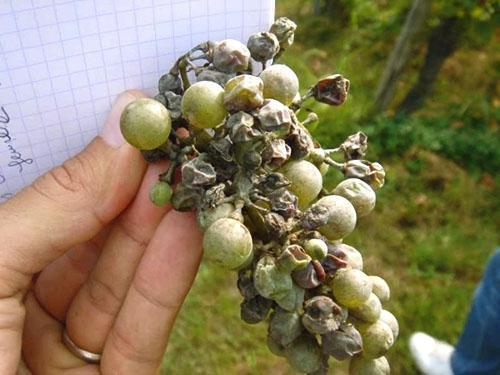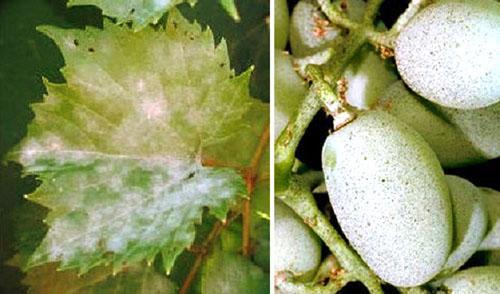How to deal with powdery mildew on grapes
 If earlier fungal diseases of grapes were not very often reminded of themselves, now this problem is becoming more and more urgent. One of the most common is the mildew grape disease, which affects an increasing number of plants in all regions of the country, causing a lot of trouble for winegrowers.
If earlier fungal diseases of grapes were not very often reminded of themselves, now this problem is becoming more and more urgent. One of the most common is the mildew grape disease, which affects an increasing number of plants in all regions of the country, causing a lot of trouble for winegrowers.
What is oidium?

The largest epidemics of oidium occur after winter frosts (the temperature should not fall below -30 ° C). Disputes of the disease persist under the scales of the eyes, and when the temperature rises to + 18 ° C ... + 25 ° C, they begin to germinate. Promotes the development of fungus and high humidity. But rains can significantly slow down, and in some cases stop its spread.
To reduce the chances of infection in grapes, it is necessary to select varieties that have a high resistance to disease, remove excess shoots, cut off diseased plant parts and burn them. You should not use fertilizers with an excess of nitrogen.
Signs of the disease
 The symptoms of powdery mildew, manifested at different times of the year, differ.
The symptoms of powdery mildew, manifested at different times of the year, differ.
In the spring, the following symptoms appear:
- Yellowing of young shoots and leaves covered with off-white, flour-like bloom.
- The edges on the leaves dry out and bend.
- Under the white bloom, brown spots begin to appear on the green shoots. If you try to erase the plaque, you will smell of rotten fish.
- With severe damage, the growth of shoots is disrupted, and their tissues begin to die off.
 In summer, these signs are somewhat different:
In summer, these signs are somewhat different:
- Flowers and young bunches dry out, and the crests of leaves become brittle.
- As they grow, young berries become covered with dark spots, and later a reticular pattern appears on them and corking occurs.
- The berries begin to crack and rot. The development of the disease on them can continue until harvest.

Prevention and control of disease
 If powdery mildew was found on grapes, how to deal with it becomes a very urgent issue. There are several ways to get rid of this fungal disease.
If powdery mildew was found on grapes, how to deal with it becomes a very urgent issue. There are several ways to get rid of this fungal disease.
Use of sulfur and sulfur preparations
 Being in a dispersed form, sulfur is very effectively absorbed by the fungus, where it turns into hydrogen sulfide, which kills it. It is best to treat with sulfur in the morning or in the evening, because in extreme heat, burns can occur on the leaves and fruits. Processing is repeated every 10-20 days. For prophylaxis, it is necessary to dissolve 25-40 grams of sulfur in 10 liters of water, and for treatment, 80-100 grams.
Being in a dispersed form, sulfur is very effectively absorbed by the fungus, where it turns into hydrogen sulfide, which kills it. It is best to treat with sulfur in the morning or in the evening, because in extreme heat, burns can occur on the leaves and fruits. Processing is repeated every 10-20 days. For prophylaxis, it is necessary to dissolve 25-40 grams of sulfur in 10 liters of water, and for treatment, 80-100 grams.
Before sprinkling grapes, it should be noted that sulfur treatment is effective only at an air temperature of more than + 20 ° C, at lower temperatures it is ineffective. If the temperature drops below, then it should be treated with colloidal sulfur or one of the sulfur preparations.
Contact and systemic drugs
During the ripening of berries, chemicals should not be used. Therefore, a solution of potassium permanganate is used to delay the development of the disease. For treatment, complex preparations are best suited, which are allowed for use during maturation.
Biological methods against powdery mildew
 The most accessible of all methods is to prepare concentrated saprophytic microflora from humus in the spring. It is done in the following way: one-third of a one-liter barrel is covered with humus and filled with water heated to 25 ° C, then covered with burlap and waited for 6 days in warmth, stirring regularly.
The most accessible of all methods is to prepare concentrated saprophytic microflora from humus in the spring. It is done in the following way: one-third of a one-liter barrel is covered with humus and filled with water heated to 25 ° C, then covered with burlap and waited for 6 days in warmth, stirring regularly.
Strain the resulting substance through cheesecloth and pour into a sprayer. When carrying out prophylaxis, it is sprayed onto freshly blossoming grape leaves. The action is based on the penetration of microflora under the scales of the kidneys and getting it on fungal spores, which are a nutrient for it. Processing is carried out on a cloudy day or in the evening.
Re-treatment should be done after seven days, and another one before flowering. With a strong development of infection, at the end of flowering, it is necessary to process the plant several more times at intervals of a week.
Folk ways of protection
- During the day, insist half a bucket ash in seven liters of water. Before processing, it should be diluted with water in a 1: 1 ratio and 10 grams of green soap should be added. If there is a lack of time, the ash can be boiled for 20 minutes.
- Pour straw dust or fresh manure with water in a 1: 3 ratio. Insist for three days. Dilute with three more parts of water and process in the evenings at any time.